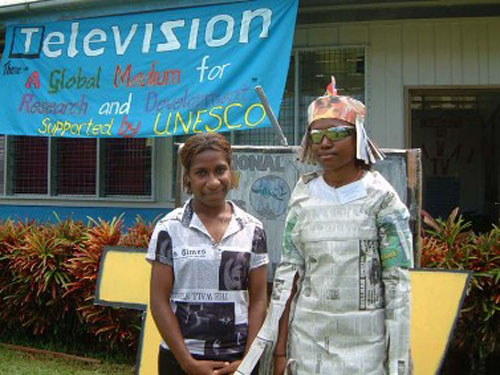
The Pacific Islands region is the world’s largest newsbeat. Just over half a million square kilometres of land are scattered across an ocean covering 166 million square kilometres in total, or one-third of the earth’s surface. Only a few of these islands are what anyone would call sizable. The Papua New Guinean half of the island of New Guinea (shared with Indonesia), accounts for approximately 80 percent of land area in the region. The other 20 percent is divided among two dozen or so “high” or volcanic islands, such as Guadalcanal in the Solomon Islands, and literally thousands of coral islets and atolls.
The term “Pacific Islands” here refers to islands populated primarily by Micronesian, Polynesian or Melanesian people. It excludes Hawai’i and New Zealand because, though geographically and culturally similar, their history and media development particularly differs markedly from the rest of the Pacific. Large numbers of colonial settlers migrated to Hawai’i and New Zealand in the nineteenth and early twentieth centuries, and set up permanent communities that established Western press systems and “free press” frameworks. The existing Polynesian societies were thus empowered by influences from North America and Asia in the case of Hawai’i, and Europe in the case of New Zealand.
It has been more than 10 years that most Pacific Island nations have been independent. Decolonisation involved a high level of indigenous participation, unlike elsewhere in the Third World. Post-independence goals reflected the ideals of democracy, equality and traditional rights, but with unique challenges. These include small, isolated populations, limited land, few resources and rudimentary transportation and communication infrastructure. Yet the media, though urged to assist with national development, were free to report the news of the day.
In 1987, however, three events occurred which were to seriously threaten media freedom. Two Fiji coups, one in May and the second in September, saw radio stations occupied by government troops and newspapers closed. Journalists were beaten and jailed, self-censorship became a pervasive practice. Then, in November the same year, the Papua New Guinea (PNG) Minister for Communication, Gabriel Ramoi, brought before cabinet a draft media tribunal bill designed to subject all media (including video and outdoor advertising) to an annual licensing process and to ensure government reflected “PNG values”. Though strenuously opposed by a variety of citizens groups and the opposition, it survived three draftings and was defeated only when a 1988 vote-of-no-confidence unseated the Wingti government.
These events seemed to indicate the beginning of a transitional period in government respect for liberal press traditions.
Layton, Suzanna (1993). Media freedom in the Pacific Islands: A comparative analysis of eight nations and terriitories. Unpublished doctoral thesis. St Lucia, Brisbane: Department of Journalism. University of Queensland. Full text available @ http://tinyurl.com/4uusv9k


